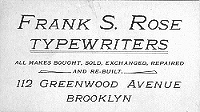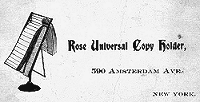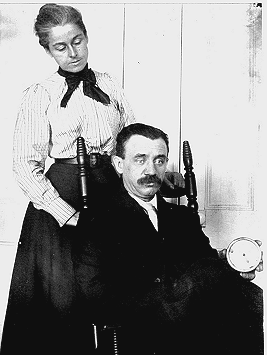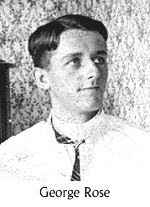|



|

This is
the only known photograph of Frank S Rose, pictured with his wife Catherine in
April 1900. Frank is holding an invention called the 'Office Indicator',
thought to be a clockwork dial indicating when the office is open and
closed. Rose was born around 1860. At the time of this photo he, his wife
and their son George, lived in Windsor Terrace, Brooklyn. Rose was a mechanical
engineer, inventor and entrepreneur and the business cards which survived among
his effects tell a story of several business ventures that suggest a growing
interest in and skill with mechanical devices. His ventures included a
business selling hardware, stoves and plumbing in Main Street, Cobleskill, New
York. Some time later he had developed his growing interest in typewriters
because he had set up in business at 112 Greenwood Avenue Brooklyn advertising
'Typewriters - All makes bought, sold, exchanged, repaired and re-built.'
Frank was clearly keen to see his name on some of the torrent of inventions that
deluged the US Patent Office at the turn of the Twentieth Century.  His early
inventions included a typist's copy stand, the Rose Universal Copy Holder, which
he sold (and perhaps manufactured) at 590 Amsterdam Avenue, New York. Frank Rose was in poor health as early as 1900. The photo of himself and his
wife is annotated, 'Mr and Mrs F. S. Rose. Taken soon after an Hospital
experience: not fully recovered health and flesh.' Whatever the state of his
physical health, Frank was at the peak of his inventive powers, because it was
in the next three years that he devised and worked out the details of the Rose
Typewriter. Presumably also he and the family moved during this time to Newark,
New Jersey, because that is the residence given in his patent application of 11
February 1903 for a 'Type Writing Machine'. Just over one year later, on 8 March
1904, the Patent was granted. It was probably in late 1906 that Wall Street
promoter John Thompson, published a prospectus for The Rose Typewriter Company,
of New York, with initial capital of $150,000. The prospectus shows
what
appears to be a model of the Rose Typewriter on its cover. The prospectus says;
His early
inventions included a typist's copy stand, the Rose Universal Copy Holder, which
he sold (and perhaps manufactured) at 590 Amsterdam Avenue, New York. Frank Rose was in poor health as early as 1900. The photo of himself and his
wife is annotated, 'Mr and Mrs F. S. Rose. Taken soon after an Hospital
experience: not fully recovered health and flesh.' Whatever the state of his
physical health, Frank was at the peak of his inventive powers, because it was
in the next three years that he devised and worked out the details of the Rose
Typewriter. Presumably also he and the family moved during this time to Newark,
New Jersey, because that is the residence given in his patent application of 11
February 1903 for a 'Type Writing Machine'. Just over one year later, on 8 March
1904, the Patent was granted. It was probably in late 1906 that Wall Street
promoter John Thompson, published a prospectus for The Rose Typewriter Company,
of New York, with initial capital of $150,000. The prospectus shows
what
appears to be a model of the Rose Typewriter on its cover. The prospectus says;
| The aim of the inventor,
Mr F.S. Rose, while designing and constructing the ROSE TYPEWRITER was to
produce a machine that would combine, as nearly as possible, all of the merits
of the high grade typewriters now in use with a minimum of working parts, a
maximum of strength and durability, and a minimum of weight, also a machine that
would meet the demands of the skilled operator, and yet be so simple that any
ordinary intelligent person could understand and operate it easily. This we
believe has been accomplished. |
The use of the past tense here perhaps
suggests that its inventor is already dead. This is borne out by the fact that
when the company is actually formed and becomes operational in or shortly before
February 1907, it is not Frank Rose who is its first President but M. W. Hazen.
According to Otto Petermann, an early recruit to the fledgling company and the
man who would later be chiefly responsible for the design of the Corona 3, Frank
Rose had died before the Rose Company was founded and that it was George Rose
who had founded the company with his father's patent. It is thus ironic
that, when he was finally on the brink of his greatest success, Frank Rose did
not live to see his invention in production.
The Rose Typewriter Company prospectus was clearly successful in
raising capital because a small loft factory was established at 2234 8th Avenue
with four workers, probably in late 1906 or early 1907. In March 1907, Otto
Petermann started work as a drill press operator at $14 per week. It was not
until a year later in March 1908, Petermann later recalled, that the first
production machine came off the line. After a slow start production seems to have got under
well way, judging from the serial numbers allocated to early machines. The
records show that from a nominal start up date of 1906 to July 1910, serial
numbers 1 to 5,570 were allocated and from July 1910 to February 1912 (when the
Corona 3 was launched) serial numbers 5,571 to 19,999 were allocated. In June 1908, Rose Typewriter Company moved to a larger loft
factory at 447 West 26th Street, New York where it began manufacture of the
'Standard Folding Typebar Visible Typewriter'. Events then move swiftly.
According to legend, sometime in 'early 1909' New York
Senator Benn Conger sees a fellow train passenger typing on an odd-looking
portable aluminium typewriter, the Rose machine. In July 1909, Conger and two
fellow investors buy the company and its patent from George Rose and form The
Standard Typewriter Company. According to a family story passed down, Catherine
and George Rose received £150,000 for the patent rights. In July-August 1909, Conger bought the Groton Carriage Works
and moved the company from New York to Groton, where, on 31 August 1909, Otto
Petermann started work as head of the 'experimental' department. It was now that
production began of the 'Model 1' Standard Folding Typewriter. In Summer 1910, the 'Model 2' Standard Folding Typewriter was
launched. One material difference is that the Cap and Fig keys are moved
together to the left side of the keyboard. In December 1910, Benn Conger and his
partners went public, offering 1,000 shares of preferred stock to raise
$100,000. The share prospectus says the company is making 100 machines per week
and plans to double this capacity 'within a few months'. Longer term plans
envisage manufacturing 400-500 per week by 1912. Between late 1910 and early 1912, Otto Petermann began work
designing the Standard Folding Typewriter No 3. In 1911, the name of the machine
is changed to 'Corona 3' with 'Standard Folding Typewriter' underneath in small
letters. In the last week of February 1912, the Corona 3 was finally launched.
Nothing was ever quite the same again.
|